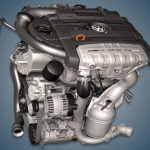The 2.0-liter Volkswagen CAWA 2.0 TSI engine was produced by the concern from 2008 to 2011 and was installed on the first generation Tiguan crossover, which is very popular in many countries. There is a version of this unit for the American market under its own CCTB index.
The EA888 gen1 series includes: BYT, BZB, CABA, CABB, CABD, CAWA, CAWB, CBFA, CCTA, CCTB.
Specifications
| Production years | 2008-2011 |
| Displacement, cc | 1984 |
| Fuel system | direct injection |
| Power output, hp | 170 |
| Torque output, Nm | 280 |
| Cylinder block | cast iron R4 |
| Block head | aluminum 16v |
| Cylinder bore, mm | 82.5 |
| Piston stroke, mm | 92.8 |
| Compression ratio | 9.6 |
| Features | DOHC |
| Hydraulic lifters | yes |
| Timing drive | chain |
| Phase regulator | on the intake shaft |
| Turbocharging | KKK K03 |
| Recommended engine oil | 5W-30 |
| Engine oil capacity, liter | 4.6 |
| Fuel type | petrol |
| Euro standards | EURO 4 |
| Fuel consumption, L/100 km (for VW Tiguan 2009) — city — highway — combined |
13.5 7.7 9.9 |
| Engine lifespan, km | ~300 000 |
| Weight, kg | 152 |
The engine was installed on:
- Volkswagen Tiguan 1 (5N) in 2008 – 2011.
Disadvantages of the VW CAWA engine
- The weak point of this motor is the timing chain, it is already stretched to 100,000 km;
- Also, the oil separator clogs very quickly here, which leads to lubricant consumption;
- It is not uncommon for pistons to crack from detonation, but forged alternatives exist;
- The culprit of floating engine speeds is usually carbon deposits on the intake valves;
- They also become overgrown with soot, and then the swirl flaps of the intake manifold jam;
- If you pull for a long time with the replacement of candles, you will have to spend money on ignition coils






